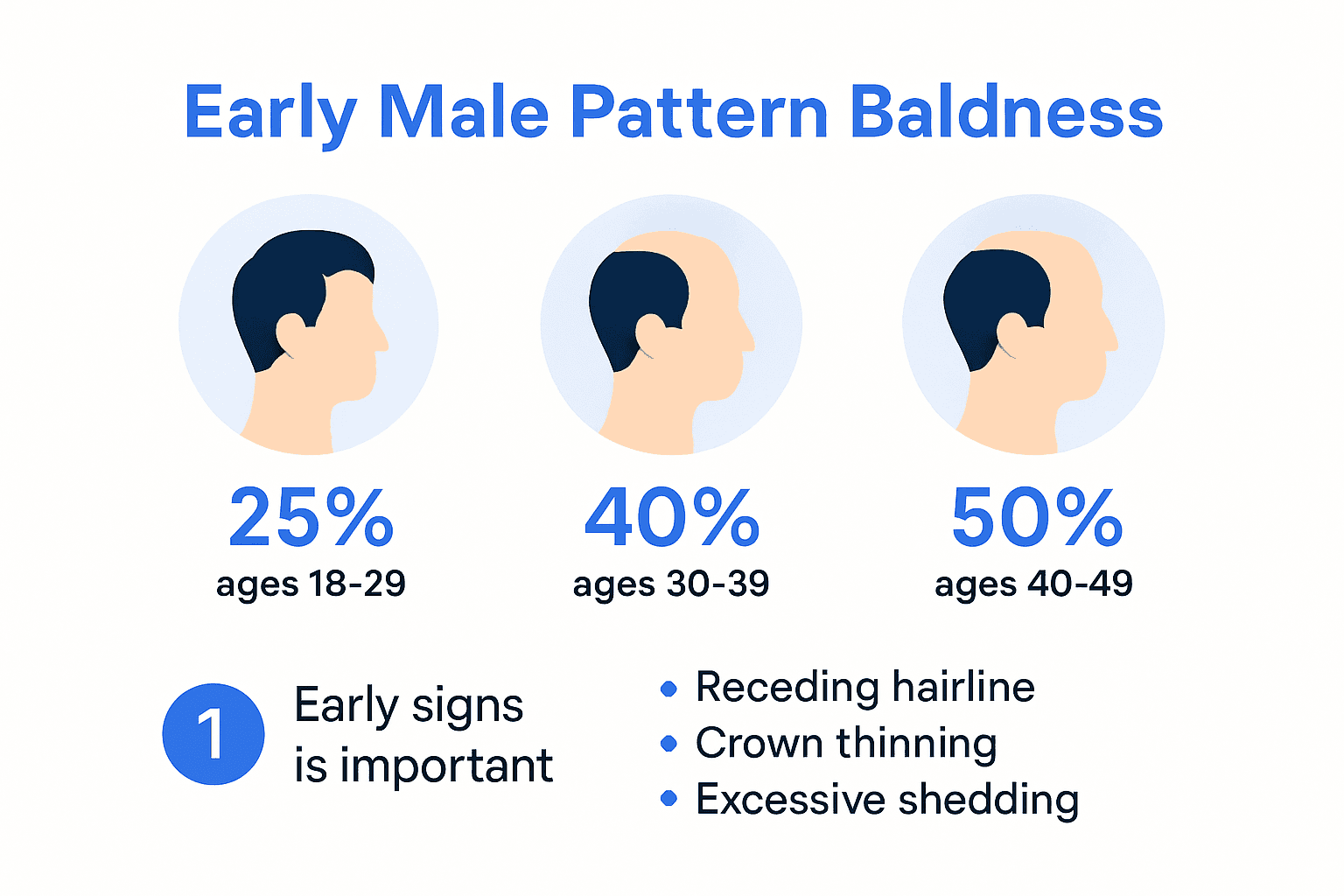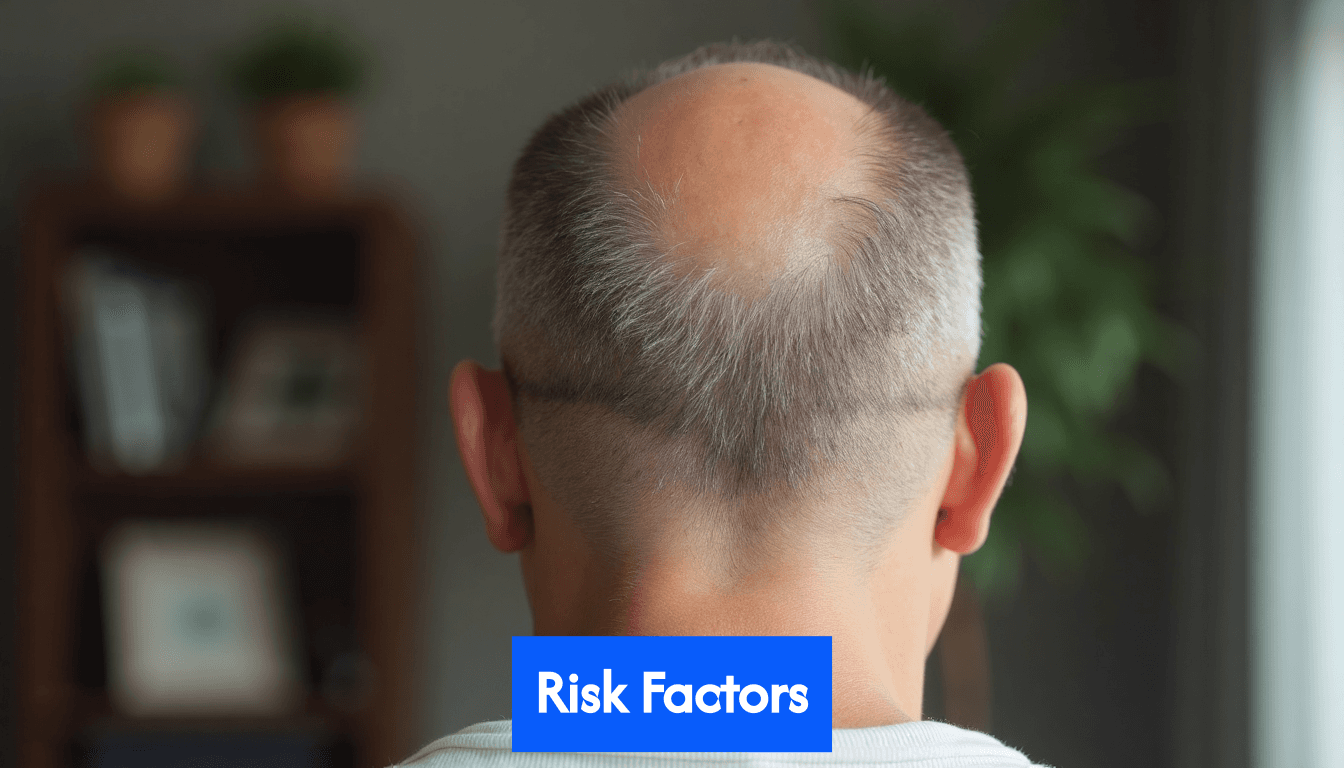Blog
Learning Materials
Early Male Pattern Baldness: Causes, Signs, and Smart Solutions for 2025
Updated: June 26, 2025

Early male pattern baldness is showing up faster than ever, with almost 25 percent of men seeing clear thinning by age 21. Think a little hair on the pillow is no big deal? That number proves things get serious much sooner than most guys realize. The twist is this rapid hair loss is now being tracked and managed using AI tech and custom care plans that didn't exist even a few years ago. Suddenly, hairlines are about more than genetics—they are a data story with real solutions on the horizon.
Table of Contents
- Identifying Early Signs Of Male Pattern Baldness
- Main Causes And Risk Factors For Early Hair Loss
- Top Treatment Options And Hair Growth Tracking
- Personalized Hair Care Solutions And Brand Innovations
Quick Summary
| Takeaway | Explanation |
|---|---|
| Recognize Early Signs of Baldness | Look for initial hairline changes, crown thinning, and accelerated shedding to identify early male pattern baldness for proactive management. |
| Understand Genetic and Environmental Factors | Hair loss is influenced by genetics, hormonal changes, lifestyle choices, and environmental factors, emphasizing the need for individualized assessments. |
| Explore Treatment Options | Effective treatments include pharmaceutical options like finasteride and minoxidil, as well as emerging regenerative technologies and AI tracking solutions for hair growth. |
| Utilize Personalized Care | Advanced technologies enable custom formulation of hair care treatments based on genetic profiles and environmental influences, enhancing effectiveness. |
| Monitor Progress with AI | Implement AI-powered monitoring tools to track hair health and adjust treatment strategies dynamically based on individual responses. |
Identifying Early Signs of Male Pattern Baldness
Male pattern baldness creeps in silently, often catching men off guard before they realize significant hair loss is underway. Understanding the early warning signs becomes crucial for proactive management and potential intervention.

Initial Hairline Changes
The first visual indicator of early male pattern baldness typically manifests through distinctive hairline transformations. Research from the Cleveland Clinic reveals that men may start experiencing noticeable changes as early as their late teens or early 20s. The classic progression involves a gradual recession at the temples, creating what hair specialists often refer to as an "M" shaped hairline.
Specifically, you might observe:
- Subtle Temple Recession: Hair gradually pulling back from the forehead's front edges
- Increased Visibility of Forehead: More scalp becoming visible as hair thins
- Asymmetrical Hairline Patterns: Uneven recession that might differ on each side
Crown Thinning and Volume Reduction
Beyond the hairline, the crown area represents another critical zone for early male pattern baldness detection. According to the Mayo Clinic, approximately 25% of men experience noticeable hair volume reduction before age 30. This thinning often begins subtly - perhaps with increased visibility of scalp through hair or a general decrease in hair density.
Key indicators include:
- Widening Part: Your hair part becoming broader over time
- Reduced Hair Thickness: Individual hair strands appearing finer
- Increased Scalp Visibility: More skin showing through previously dense hair regions
Accelerated Hair Shedding Patterns
While some hair loss is normal, early male pattern baldness presents a more consistent and progressive shedding pattern. Hair Science research suggests tracking your daily hair loss can provide critical insights. Typical signs include finding more hair on pillows, in shower drains, or during routine combing.
Consider these diagnostic markers:
- Excessive Daily Hair Loss: More than 50-100 strands per day
- Slower Hair Regrowth: Noticeably longer periods between hair replacement
- Changes in Hair Texture: Hair becoming progressively thinner and more brittle
To gain deeper insights into your specific hair health trajectory, check out our comprehensive hair tracking solutions that use advanced AI technology to monitor and predict potential hair loss patterns.
Recognizing these early signs empowers you to take proactive steps. Early detection doesn't guarantee prevention, but it significantly increases your chances of managing and potentially slowing down the progression of male pattern baldness.
Main Causes and Risk Factors for Early Hair Loss
Understanding the underlying mechanisms driving early male pattern baldness requires a comprehensive exploration of complex biological and environmental factors. While genetics play a pivotal role, multiple interconnected elements contribute to premature hair loss.

Genetic Predisposition and Hormonal Influences
Research from the National Institutes of Health reveals that male androgenetic alopecia (MAA) affects 30-50% of men by age 50, with genetic sensitivity to dihydrotestosterone (DHT) being the primary driver. Hereditary factors determine how your hair follicles respond to hormonal changes, making family history a critical predictor of potential hair loss.
Key genetic risk factors include:
- Androgen Receptor Sensitivity: Genetic variations affecting how hair follicles respond to male hormones
- Inherited Hair Follicle Structure: Predisposition to miniaturization of hair follicles
- Familial Patterns: Higher risk if male relatives experienced early baldness
Lifestyle and Environmental Triggers
Scandinavian Biologic Labs research highlights that approximately 25% of men begin balding before age 21, with lifestyle factors significantly impacting hair loss progression. Stress, nutrition, and environmental exposures play crucial roles in accelerating or mitigating hair loss.
Significant lifestyle contributors include:
- Chronic Stress: Hormonal imbalances that impact hair growth cycles
- Nutritional Deficiencies: Lack of essential vitamins and minerals
- Environmental Toxins: Exposure to pollutants and chemical stressors
Medical Conditions and Treatment Impacts
World Population Review studies demonstrate that medical conditions and treatments can dramatically influence hair loss patterns. Certain medications, hormonal treatments, and underlying health conditions can accelerate or trigger early male pattern baldness.
Notable medical risk factors encompass:
- Autoimmune Disorders: Conditions that attack hair follicles
- Medication Side Effects: Blood pressure drugs, antidepressants, and other treatments
- Hormonal Imbalances: Thyroid disorders and testosterone fluctuations
For personalized insights into your specific hair loss risk factors, explore our advanced hair health tracking solutions that analyze individual genetic and environmental influences.
Recognizing these multifaceted causes empowers individuals to take proactive steps. While some factors remain beyond personal control, understanding your unique risk profile can help develop targeted strategies for managing early male pattern baldness.
Top Treatment Options and Hair Growth Tracking
Navigating the landscape of male pattern baldness treatments requires a strategic approach that combines medical interventions, technological tracking, and personalized care strategies. The evolving field of hair restoration offers multiple pathways for managing and potentially reversing early hair loss.
Pharmaceutical and Topical Treatments
Research from leading medical resources reveals that pharmaceutical interventions remain the most established approach to combating male pattern baldness. Two primary medications dominate the treatment landscape: finasteride and minoxidil.
Key pharmaceutical approaches include:
- Finasteride: A 5-alpha reductase inhibitor that blocks testosterone conversion to DHT
- Topical Minoxidil: A vasodilator that stimulates blood flow to hair follicles
- Combination Therapies: Integrated treatments maximizing hair regrowth potential
Emerging Regenerative Technologies
Stem cell research is revolutionizing hair restoration with groundbreaking approaches. Innovative therapies utilizing adipose-derived and hematopoietic stem cells demonstrate remarkable potential for targeting hair loss at its cellular origin.
Cutting-edge regenerative techniques encompass:
- Stem Cell Therapies: Targeting follicular regeneration
- Platelet-Rich Plasma (PRP) Treatments: Using body's own healing mechanisms
- Advanced Cellular Interventions: Precision-based follicular restoration
AI-Powered Hair Growth Monitoring
Clinical trials of emerging treatments highlight the importance of precise tracking and personalized monitoring. Advanced AI technologies now enable unprecedented insights into individual hair loss patterns and treatment effectiveness.
Technological tracking features include:
- Digital Scalp Mapping: Comprehensive visualization of hair density changes
- Growth Progression Analytics: Quantitative tracking of hair restoration
- Personalized Treatment Recommendations: AI-driven interventional strategies
Discover our comprehensive hair growth tracking solutions that leverage cutting-edge AI technology to provide real-time insights into your unique hair health journey.
The future of male pattern baldness management lies in personalized, technology-driven approaches that combine medical science with individual genetic profiling. By understanding your specific hair loss trajectory and leveraging advanced tracking technologies, you can develop a targeted strategy for maintaining and potentially restoring your hair's natural vitality.
Personalized Hair Care Solutions and Brand Innovations
The landscape of male hair restoration is rapidly transforming, moving beyond generic treatments to embrace highly individualized solutions that recognize the unique genetic and environmental factors influencing hair health. Modern innovations are redefining how men approach hair loss management.
Custom Formulation Technologies
Research from pharmaceutical development experts reveals that 2025's most advanced hair care solutions leverage precision medicine principles. Custom formulations now combine scientifically proven ingredients like minoxidil and biotin, tailored specifically to individual hair restoration profiles.
Key characteristics of personalized hair care include:
- Genetic Profiling: Customizing treatments based on individual DNA markers
- Metabolic Analysis: Understanding how personal biochemistry impacts hair growth
- Targeted Ingredient Combinations: Precise mixtures addressing specific hair loss patterns
Advanced Regenerative Approaches
Innovative treatment research demonstrates remarkable progress in regenerative technologies. Emerging solutions move beyond traditional pharmaceutical interventions, focusing on cellular-level hair restoration strategies.
Cutting-edge regenerative techniques encompass:
- Stem Cell Therapies: Stimulating natural follicle regeneration
- Growth Factor Concentrates: Enhancing cellular repair mechanisms
- Biomimetic Peptide Treatments: Developing protein-based hair restoration strategies
AI-Enhanced Personalization
Our technological ecosystem represents a quantum leap in personalized hair care. Explore our holistic hair care solutions that integrate artificial intelligence with comprehensive health tracking, providing unprecedented insights into individual hair restoration journeys.
AI-powered personalization features include:
- Real-Time Scalp Monitoring: Continuous tracking of hair health indicators
- Predictive Growth Modeling: Forecasting potential hair restoration outcomes
- Dynamic Treatment Adjustment: Algorithms that refine recommendations based on individual response
The future of male pattern baldness management lies not in universal solutions, but in recognizing and addressing each individual's unique biological blueprint. By combining advanced medical research, regenerative technologies, and intelligent tracking systems, we are entering an era where personalized hair care is not just a possibility, but a standard approach to hair health.
Understanding that every hair loss journey is distinct empowers men to take control, moving beyond traditional treatment paradigms toward truly customized restoration strategies.
Frequently Asked Questions
What are the early signs of male pattern baldness?
The early signs of male pattern baldness include changes in the hairline, such as subtle recession at the temples, crown thinning, and increased hair shedding, with more hair found on pillows or during grooming.
What causes early male pattern baldness?
Early male pattern baldness is primarily caused by genetic predisposition and hormonal influences like dihydrotestosterone (DHT). Lifestyle factors, such as stress and nutrition, as well as certain medical conditions and medications, can also contribute.
What treatment options are available for early male pattern baldness?
Treatment options include pharmaceutical solutions like finasteride and minoxidil, emerging regenerative technologies such as stem cell therapies, and AI-powered hair growth monitoring systems to track progress.
How can I monitor my hair growth effectively?
You can monitor your hair growth effectively using AI-powered tracking tools that analyze scalp density changes and provide personalized treatment recommendations based on your unique hair health profile.
Take Back Control: Spot Early Baldness and Personalize Your Hair Regrowth Journey
Are you worried about seeing your hairline creeping back or more strands in the shower? This article showed just how fast early male pattern baldness can progress, especially with signs like temple recession, crown thinning, and rapid shedding showing up sooner than most expect. It's easy to feel powerless watching these changes, but you actually have smarter options now—especially with the power of AI-driven analysis and personal recommendations.

Ready to stop guessing and start acting? Get a detailed, personalized hair health assessment using MyHair.ai. Upload your scans, let our advanced AI reveal your unique hair loss patterns, and receive custom growth projections along with tailored product suggestions that fit your DNA and lifestyle. Stay ahead of the curve and track your regrowth journey over time with easy, insightful updates. Take the first step now with MyHair.ai and give yourself the chance to slow, manage, or even reverse those early changes. Your future hair could start with one scan today.